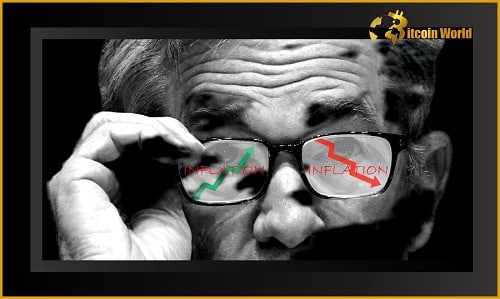Inflation is on everyone’s mind, and it’s not just dinner table conversation anymore. We’re seeing it reflected in rising prices everywhere, from gas at the pump to groceries at the store. Just how serious is it? Well, consumer prices in the United States surged by a whopping 6.8% in November 2021 compared to the year before. That’s the steepest climb we’ve seen since 1982! No wonder everyone’s feeling the pinch.
Powell’s Stance: Inflation is Top Priority
Enter Jerome Powell, the Chairman of the Federal Reserve. As he gears up for his second term, Powell is making it crystal clear where his focus lies: tackling this persistent inflation. Ahead of his Senate confirmation hearing, Powell released comments reaffirming his commitment. In no uncertain terms, he stated, “We will use our tools to support the economy and a strong labor market and to prevent higher inflation from becoming entrenched.” This is a strong signal that the Fed is taking inflation very seriously and is prepared to act.
But what exactly does ‘using our tools’ mean? For the Federal Reserve, these tools primarily involve managing interest rates and the money supply. Raising interest rates, for example, can make borrowing more expensive, which in turn can cool down economic activity and potentially curb inflation. Powell’s commitment suggests we might see more assertive moves from the Fed in the coming months to keep price increases in check.
Bitcoin: The Inflation Hedge Narrative
Amidst all this inflationary pressure, Bitcoin has been touted by many as a potential safe haven, a sort of digital gold, if you will. The argument goes like this: Bitcoin has a capped supply of 21 million coins. Unlike traditional currencies, which central banks can print more of (potentially leading to inflation), Bitcoin’s scarcity is built into its very code. This limited supply, proponents argue, makes it an attractive hedge against inflation, a store of value that can hold its purchasing power even as fiat currencies potentially depreciate.
Since the onset of the COVID-19 pandemic in 2020, we’ve seen a surge of interest in Bitcoin as an inflation hedge. Investors, seeking to protect their wealth from the eroding effects of inflation, have increasingly turned to cryptocurrencies, with Bitcoin leading the charge.
Bitcoin’s Recent Performance: Has the Hedge Held Up?
However, the reality of Bitcoin’s performance as an inflation hedge has been a bit more complex, especially recently. While the narrative is compelling, the price action hasn’t always mirrored the inflation story perfectly.
Let’s look at the numbers. Many expected Bitcoin to skyrocket to or even beyond the US$100,000 mark by the end of 2021. That didn’t happen. Instead, Bitcoin struggled to break past previous highs and, in fact, experienced a significant pullback, even dipping below US$40,000 for the first time since August 2021, according to Coingecko data.
So, what gives? If Bitcoin is supposed to be this ultimate inflation hedge, why hasn’t it performed as expected during a period of high inflation? There are a few potential factors at play:
-
Market Volatility: The cryptocurrency market is known for its volatility. Bitcoin’s price can be influenced by a wide range of factors beyond just inflation, including regulatory news, technological developments, market sentiment, and macroeconomic events. This inherent volatility can sometimes overshadow its potential as an inflation hedge in the short term.
-
Risk-On Asset: Despite the inflation hedge narrative, Bitcoin is still largely perceived as a risk-on asset. In times of economic uncertainty or market corrections, investors may reduce their exposure to riskier assets like Bitcoin in favor of safer havens, even if inflation is a concern.
-
Correlation vs. Causation: While there might be some correlation between inflation and Bitcoin’s price over longer periods, it’s not a guaranteed, direct relationship. Many other factors can influence Bitcoin’s price in the short to medium term, making it less of a straightforward inflation hedge than some might believe.
-
Maturing Market: As the cryptocurrency market matures, Bitcoin’s price behavior might evolve. What worked in the past may not necessarily hold true in the future. The market is becoming more complex, with institutional investors playing a larger role, and this can influence price dynamics.
Looking Ahead: Inflation, Powell, and Bitcoin’s Role
Jerome Powell’s commitment to tackling inflation is a significant development. The Fed’s actions will be crucial in determining the trajectory of inflation in the US and globally. If the Fed is successful in curbing inflation, it could potentially reduce the urgency for investors to seek inflation hedges like Bitcoin.
On the other hand, if inflation proves to be more persistent than anticipated, or if the Fed’s actions are perceived as insufficient, the appeal of assets like Bitcoin as inflation hedges could strengthen once again.
It’s also important to remember that Bitcoin’s story is still unfolding. Its role as an inflation hedge is a complex and evolving narrative. While recent performance might raise questions, the fundamental arguments for Bitcoin’s scarcity and its potential as a store of value remain relevant.
Ultimately, whether Bitcoin will truly solidify its position as the ultimate inflation hedge remains to be seen. It will likely depend on a combination of factors, including the effectiveness of central bank policies in managing inflation, broader market sentiment, and the continued evolution of the cryptocurrency market itself.
Related Posts – Ex-SEC Chair, Jay Clayton Believes Cryptocurrency Industry Is For Long Haul
Disclaimer: The information provided is not trading advice, Bitcoinworld.co.in holds no liability for any investments made based on the information provided on this page. We strongly recommend independent research and/or consultation with a qualified professional before making any investment decisions.



